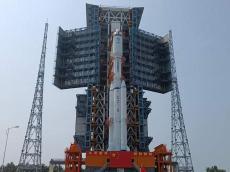|
|
TODAY.AZ / World news
China launches Chang'e-6 probe for first time
03 May 2024 [22:38] - TODAY.AZ

By Alimat Aliyeva
China has successfully launched the Chang'e-6 automatic space station to collect soil samples from the far side of the moon for the first time in history, Azernews reports.
The launch was carried out using the Changzheng-5 Y8 launch vehicle from the Wenchang cosmodrome on the southern Chinese island of Hainan. The Chang'e-6 automatic space Station consists of an orbital, landing, takeoff and return modules. As part of international cooperation, scientific instruments from France, Italy and the European Space Agency are on board the lander, and a small satellite from Pakistan is on board the orbital module.
The Apollo impact crater, located in the South Pole-Aitken basin, was chosen as the landing site on the far side of the Moon.
Chang'e-6 will make a soft landing on the moon. The device will collect samples of lunar soil using a drilling rig and a robotic bucket.
After the samples are collected and sealed in a container, the take-off module will leave the Moon and dock with the orbiter in lunar orbit. The return module will then deliver the samples back to Earth and land in northern China, in the Inner Mongolia Autonomous Region. The entire mission is expected to last 53 days. Chang'e-6, which will be located on the far side of the Moon, will be connected to Earth by the Qiuqiao-2 relay satellite.
On November 24, 2020, the Changzheng-5 launch vehicle was launched from the Wenchang Cosmodrome on Hainan Island. She sent the Chang 'e-5 spacecraft to the Moon, which returned to Earth about 23 days after launch, collecting about 2 kg of lunar soil for study by Chinese specialists both for scientific purposes and for a project to prepare for the construction of a research base.
URL: http://www.today.az/news/regions/247898.html
 Print version
Print version
Connect with us. Get latest news and updates.
See Also
- 18 May 2024 [09:00]
French railway workers plan mass strike - 18 May 2024 [08:00]
Gallons of oil spills into Gulf of Mexico as barge hits bridge in Texas - 17 May 2024 [23:22]
Earth sized planet discovered fifty five light years from Earth - 17 May 2024 [22:50]
Sixth stage of discharge of water from Fukushima nuclear power plant into ocean begins - 17 May 2024 [22:13]
Unidentified drones imperceptibly filmes largest Japanese Navy ship, US aircraft carrier - 17 May 2024 [21:19]
Kazakhstan and Latvia agreed to develop Middle Corridor - 17 May 2024 [19:36]
Tehran goads radical sects amidst restoring diplomatic bridge with Azerbaijan - 17 May 2024 [19:16]
South Korea and United States work out a nuclear strike on the DPRK during exercises - 17 May 2024 [08:00]
Council of Permanent Authorized Reps of CIS countries hold meeting in Minsk - 16 May 2024 [23:27]
Global oil production plummetes
Most Popular
 Presidents of Azerbaijan and Belarus visit Bulbul House-Museum in Shusha [PHOTOS]
Presidents of Azerbaijan and Belarus visit Bulbul House-Museum in Shusha [PHOTOS]
 Presidents of Azerbaijan and Belarus view bullet-riddled monuments [PHOTOS]
Presidents of Azerbaijan and Belarus view bullet-riddled monuments [PHOTOS]
 Presidents of Azerbaijan and Belarus familiarize themselves with Caspian Agro and InterFood Azerbaijan exhibitions [PHOTOS/VIDEO]
Presidents of Azerbaijan and Belarus familiarize themselves with Caspian Agro and InterFood Azerbaijan exhibitions [PHOTOS/VIDEO]
 Azerbaijan and Belarus sign documents [PHOTOS/VIDEO]
Azerbaijan and Belarus sign documents [PHOTOS/VIDEO]
 What kind of democracy "tourists" from EU teach Georgians?
What kind of democracy "tourists" from EU teach Georgians?
 Presidents of Azerbaijan and Belarus view Heydar Aliyev and Garabagh exhibition [PHOTOS]
Presidents of Azerbaijan and Belarus view Heydar Aliyev and Garabagh exhibition [PHOTOS]
 Azerbaijan, Belarus strengthen collaboration in urban planning, architecture
Azerbaijan, Belarus strengthen collaboration in urban planning, architecture
